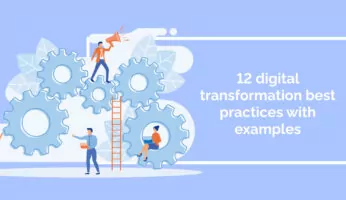
Companies who wish to achieve future-ready status know that sustainable success isn’t achieved through sporadic productivity across the organization—despite how entrepreneurial it may feel.
For leaders, ensuring employees are equipped with the talents and skills needed to drive organizational effectiveness means establishing tangible and targeted systems that measure and assess team capabilities.
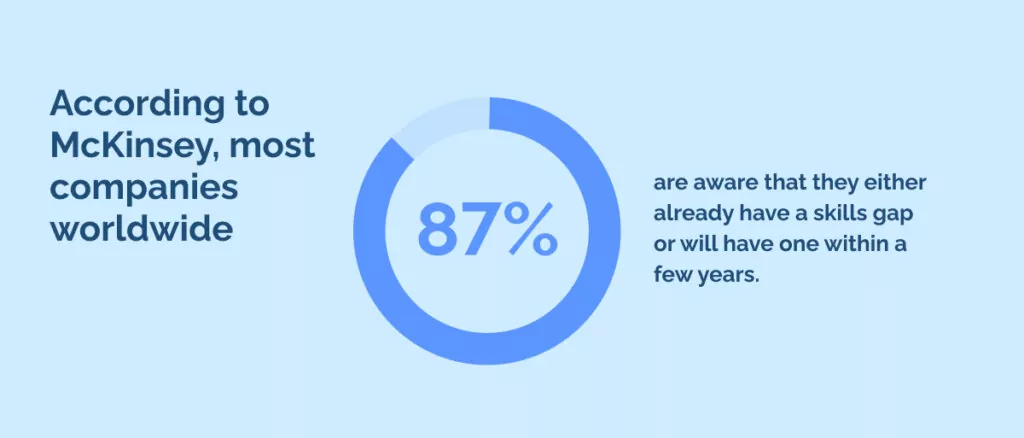
According to McKinsey, most companies worldwide (87%) are aware that they either already have a skills gap or will have one within a few years.
A skills matrix helps in this regard, providing a visual framework for determining skill levels, identifying skill gaps, and developing prospective employees, team, project, and organizational capabilities.
In this article, we’ll explore a skills matrix, uncover its benefits, and provide a step-by-step guide on creating one. We’ll also include a template example to assist you in implementing this valuable tool for talent management within your organization.
What is a skills matrix?
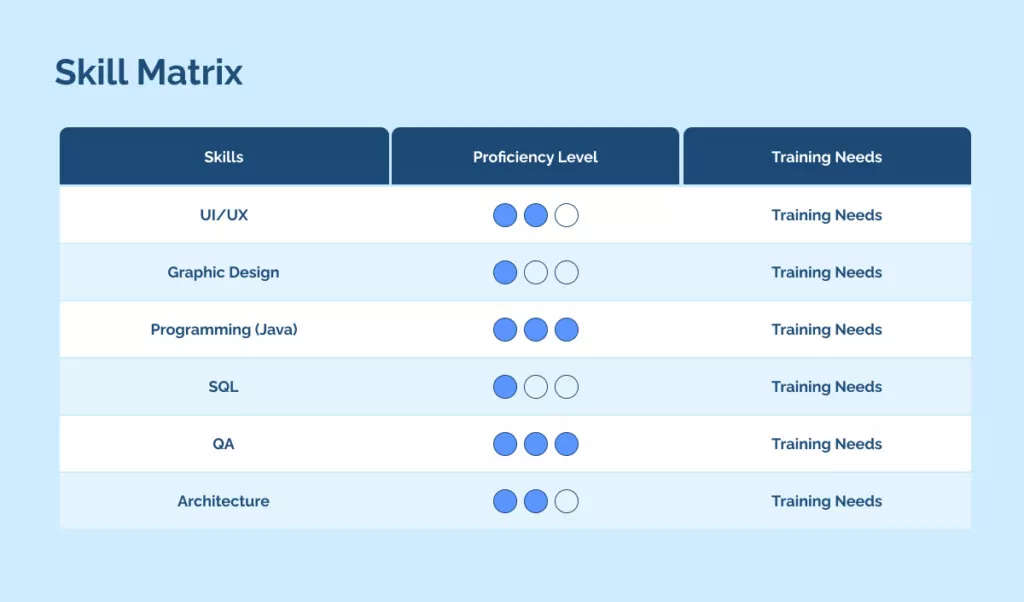
A skills matrix is a measurement system used to represent and ascertain an employee’s skill capabilities and competency levels.
Skill matrices leverage numerical statistics that capture vital skills data for strategic management, planning, and observation of teams and projects across the organization.
This framework helps organizations identify skills gaps and better understand how available skills (or lack thereof) can affect a company’s sustainability and bottom line.
A rudimentary example of a skills matrix can simply be a spreadsheet that lists employees’ names and the skills they possess.
This information can then be utilized for enhancing employee learning and development capabilities and cultivating stronger, more dynamic teams.
Top workplaces are characterized by their exceptional training programs and prioritize a people-first culture, with 85-94 percent of employees in a Workplace Survey responding positively to the statement, “My manager helps me learn and grow.”
Why is a skills matrix important?
Digital transformation trends increasingly see data-driven solutions as trusted metrics for precision-led decision-making.
Today’s businesses cannot simply rely on qualitative data that bases organizational strategy on vague interpretations and personal preferences.
The concrete data provided via a skills matrix facilitates a more effective and reliable apparatus for capturing value and achieving business outcomes.
Because skills matrices assess the end-to-end competencies of a team, team leaders are given a starting point in which they can appropriately assign tasks to the most skilled team members and achieve better project outcomes.
This ensures a more consistent method for project completion in business environments, allowing for effective resource allocation and identification of team skill gaps.
Aside from improved project management, skills matrices inform HR departments about hiring prospective employees and identifying candidates that fill the skills deficit.
Benefits of a Skills Matrix
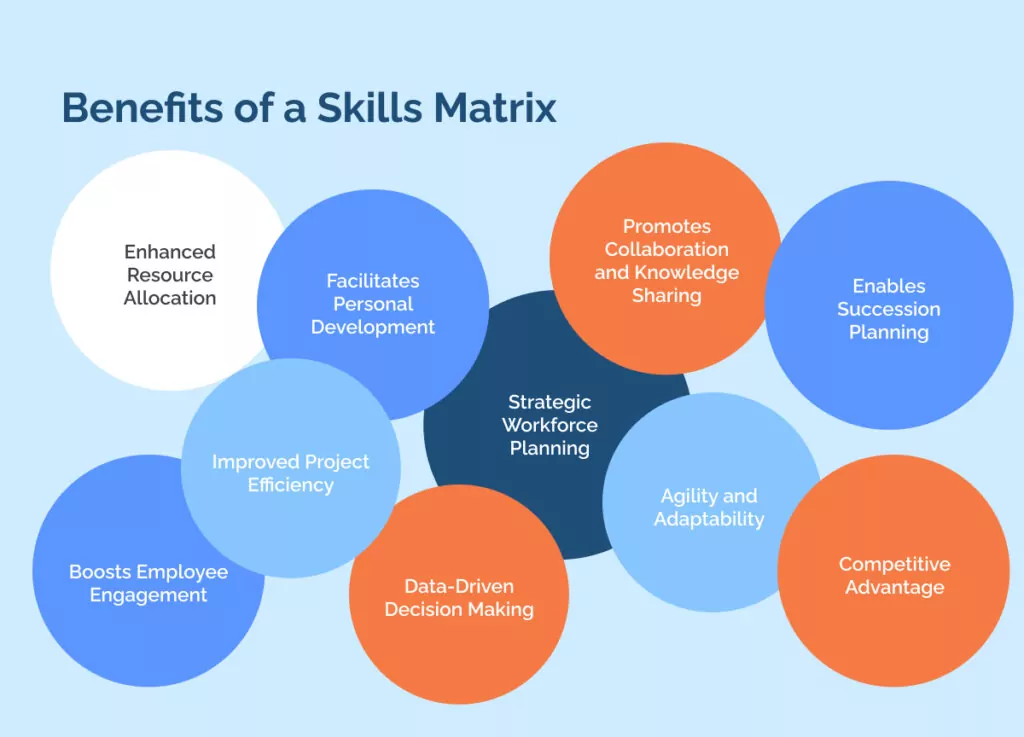
In business environments where talent and agility are paramount, the power of a skills matrix shines through, unveiling various benefits for organizations.
Below, we summarise some of the key advantages offered by a skills matrix:
Enhanced Resource Allocation
A skills matrix empowers organizations to allocate resources effectively by identifying the right individuals with the necessary expertise for each project or task, improving productivity and project outcomes.
Facilitates Personal Development
By providing employees with insights into their skills and competencies relative to others, a skills matrix enables them to identify areas for growth and set personal development goals, fostering a culture of continuous learning and development.
Promotes Collaboration and Knowledge Sharing
With visibility into the skills and competencies available within teams, colleagues can easily identify and leverage each other’s strengths, facilitating collaboration, knowledge sharing, and innovation.
Strategic Workforce Planning
By understanding the current skill landscape, managers can proactively identify skill gaps and make informed decisions about training, hiring, or reassignment to align the workforce with future strategic objectives.
Improved Project Efficiency
A skills matrix allows managers to match projects with individuals possessing the required skills, eliminating bottlenecks and ensuring that the right talent is assigned to each task, ultimately enhancing project efficiency and success rates.
Boosts Employee Engagement
Empowering employees to assess their skills and set development goals enhances their motivation and engagement and demonstrates an organization’s commitment to their individual growth and success.
Enables Succession Planning
Identifying critical skills and potential successors within the organization becomes more manageable with a skills matrix, enabling proactive succession planning and minimizing disruptions in leadership transitions.
Data-Driven Decision Making
With a comprehensive overview of skills and competencies, managers can rely on data-driven insights to make informed decisions about workforce planning, training investments, and talent acquisition strategies.
Agility and Adaptability
A skills matrix equips organizations with the agility to respond to changing market demands by quickly identifying and addressing skill gaps, enabling them to adapt and thrive in dynamic business environments.
Competitive Advantage
Leveraging the benefits of a skills matrix enables organizations to optimize their workforce, nurture talent, drive innovation, and ultimately gain a competitive edge in their industry.
How To Create a Skills Matrix
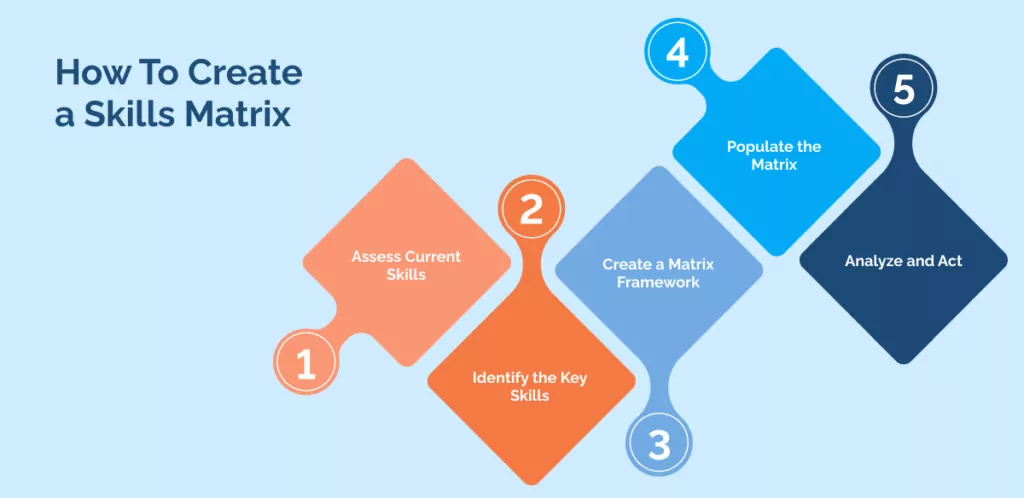
Now that we understand the significance of a skills matrix, let’s dive into the actionable steps for creating a comprehensive matrix that will enable your organization to harness the full potential of its workforce talent.
- Assess Current Skills
To begin the process, it is crucial to thoroughly evaluate the existing skillset of individuals within your organization. This can be accomplished through various means, such as conducting surveys, interviews, or utilizing self-assessment questionnaires.
Using these methods, you can collect comprehensive data on the proficiency level of each individual for every identified skill.
This detailed approach will provide a solid foundation for further analysis and decision-making regarding skill development and utilization within your organization.
- Identify the Key Skills
Next, it is important to identify and determine the key skills required for the project’s successful completion.
These skills can encompass a range of areas, including technical expertise, soft skills such as communication and teamwork, domain knowledge specific to the project’s industry, or even certain qualifications that are directly relevant to effectively carrying out the tasks involved in the project.
Conducting a thorough analysis of the required skills allows assigning the right employees with the appropriate skill set for project tasks. This method optimizes the chances of achieving project success.
- Create a Matrix Framework
Next, it’s time to strategically design a comprehensive matrix framework that aligns the identified skills along one axis and the respective individuals or team members along the other axis.
This will create a structured and organized grid-like system, enabling you to effectively map and analyze the correlation between specific skills and those possessing them.
Implementing this framework provides valuable insights into skill distribution and helps identify potential gaps or areas of expertise within your team.
- Populate the Matrix
Fill in the matrix by assigning proficiency levels to each individual for each skill.
You can use a numerical scale (1-5) or descriptive categories (beginner, intermediate, advanced) to indicate skill levels. This will help assess and understand each individual’s skill set, allowing for better alignment with project requirements and resource allocation.
Collecting this information simplifies the process of identifying areas of strength and those that may require further development or training.
A comprehensive matrix enables effective team composition and skill matching, leading to better collaboration and project outcomes.
- Analyze and Act
Analyze the completed skills matrix to identify skill gaps, areas of expertise, and potential development opportunities.
Careful examination of this information enables informed decisions on resource allocation, training needs, succession planning, and talent acquisition strategies.
This comprehensive analysis will enable you to effectively address any skill gaps, leverage existing expertise, and align development opportunities to maximize the potential of your workforce.
With a thorough understanding of your employees’ skills and areas for improvement, you can strategically plan for the future and ensure the success of your organization.
Skills Matrix Template Example
Below, we’ve created a comprehensive and user-friendly Skills Matrix Template.
It’s designed to streamline talent management and empower organizations to assess, track, and develop the skills of their team members efficiently.
Feel free to customize this template according to your specific needs and add or remove columns as required.
——————————————————————
| Skills | Proficiency Level | Training Needs |
——————————————————————
| Skill 1 | Proficiency Level | Training Needs |
| Skill 2 | Proficiency Level | Training Needs |
| Skill 3 | Proficiency Level | Training Needs |
| Skill 4 | Proficiency Level | Training Needs |
| Skill 5 | Proficiency Level | Training Needs |
| Skill 6 | Proficiency Level | Training Needs |
| Skill 7 | Proficiency Level | Training Needs |
——————————————————————
Let’s explain the above Skills Matrix Template:
- Skills: This column lists the specific skills or competencies required for the project or task.
- Proficiency Level: This column allows you to rate the team member’s proficiency in each skill using a scale such as Beginner, Intermediate, Advanced, or numerical ratings.
- Training Needs: This column helps identify any training or development needs for each skill, outlining areas where the team member may require further improvement or support.
This Skill Matrix template will help organizations to:
- Assess and monitor the proficiency levels of your team members across different skills.
- Identify training needs/create targeted development plans, and allocate resources more effectively to enhance the overall skill set of your team.
- Provides a clear overview and facilitates decision-making when assigning tasks or forming project teams based on individual strengths and areas for improvement.
Ensuring Skills for the Future of Work
In the era of digital transformation and data-driven decision-making, the value of a skills matrix in talent management is paramount.
It provides a thorough overview of an organization’s capabilities, facilitating strategic decisions for talent development and deployment.
Its ability to enable organizations to assess and track the proficiency levels of their team members across various skills, identify training needs, and improve decision-making capabilities for resource allocation makes it a no-brainer tool for managers.
With the increasing reliance on technology and the need for specialized skills, organizations must leverage the power of data, such as a skills matrix, to effectively manage their workforce.
It’s increasingly clear that organizations must opt for data-driven methods to achieve success, with Harvard Business Review stating, “ … persistence, resilience, execution, and a relentless drive to employ data to make more informed business decisions are what distinguishes those companies that prevail from those who continue to struggle.”
WalkMe Team
WalkMe spearheaded the Digital Adoption Platform (DAP) for associations to use the maximum capacity of their advanced resources. Utilizing man-made consciousness, AI, and context-oriented direction, WalkMe adds a powerful UI layer to raise the computerized proficiency, everything being equal.


